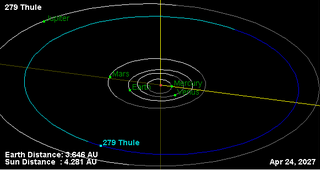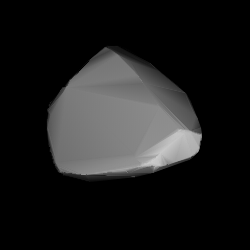
Baucis is a large main belt asteroid that was discovered by French astronomer Alphonse Borrelly on February 5, 1877, and named after a fictional character in the Greek legend of Baucis and Philemon. The adjectival form of the name is Baucidian. It is classified as an S-type asteroid based upon its spectrum.

Penelope is a large main belt asteroid that was discovered by Austrian astronomer Johann Palisa on August 7, 1879, in Pola. The asteroid is named after Penelope, the wife of Odysseus in Homer's The Odyssey. It is orbiting the Sun at a distance of 2.68 AU with an eccentricity (ovalness) of 0.18 and a period of 4.381 years. The orbital plane is tilted at an angle of 5.8° to the plane of the ecliptic.

Thule, minor planet designation: 279 Thule, is a large asteroid from the outer asteroid belt. It is classified as a D-type asteroid and is probably composed of organic-rich silicates, carbon and anhydrous silicates. Thule was the first asteroid discovered with a semi-major axis greater than 4 AU. It was discovered by Johann Palisa on 25 October 1888 in Vienna and was named after the ultimate northern land of Thule.

Desiderata is a very large main-belt asteroid. It is classified as a C-type asteroid and is probably composed of carbonaceous material.

Apolonia is a large Main belt asteroid. It was discovered by Auguste Charlois on 8 March 1893 in Nice.

373 Melusina is a large Main belt asteroid. It is classified as a C-type asteroid and is probably composed of carbonaceous material. It was discovered by Auguste Charlois on 15 September 1893 in Nice.

Siegena is a very large main-belt asteroid. It is classified as a C-type asteroid and is probably composed of primitive carbonaceous material.

388 Charybdis is a very large background asteroid, approximately 125 kilometers in diameter, that is located the outer region of the asteroid belt. It was discovered by French astronomer Auguste Charlois at the Nice Observatory on 7 March 1894. The carbonaceous C-type asteroid has a rotation period of 9.5 hours. It is probably named after Charybdis, a sea monster in Greek mythology.

Delia is a large Main belt asteroid. It was discovered by the French astronomer Auguste Charlois on 30 November 1894 in Nice. "Delia" is an epithet for the ancient Greco-Roman Moon goddess Artemis, for her birthplace at Delos. This asteroid is orbiting the Sun at a distance of 2.79 AU with an orbital eccentricity (ovalness) of 0.085 and a period of 4.64 yr. The orbital plane is tilted at an angle of 3.35° to the plane of the ecliptic.

Cyane is a typical Main belt asteroid.

Arachne is a large Main belt asteroid. It is classified as a C-type asteroid and is probably composed of carbonaceous material. It was discovered on 13 October 1895, by German astronomer Max Wolf at Heidelberg Observatory.
Chloris is a very large main-belt asteroid that was discovered by Auguste Charlois on January 7, 1896, in Nice. It is classified as a C-type asteroid and is probably composed of primitive carbonaceous material. The spectrum of the asteroid displays evidence of aqueous alteration. It is the namesake of the Chloris family of asteroids.
Liriope is a large Main belt asteroid. It is classified as a C-type asteroid and is probably composed of carbonaceous material.

Vaticana is a large Main belt asteroid.
Aurelia is a main-belt asteroid that was discovered by German astronomer Max Wolf on September 7, 1896, in Heidelberg. It is classified as an F-type asteroid.

Cornelia is a large Main belt asteroid. It was discovered by Auguste Charlois on 28 December 1896 in Nice. It is named after Cornelia Africana.
Dulcinea is an asteroid orbiting in the inner main belt. It was named after Dulcinea, a character from Miguel de Cervantes' novel Don Quixote. This is classified as a stony S-type asteroid and it is the second largest member of the Erigone collisional family.
623 Chimaera is a minor planet, specifically an asteroid orbiting in the asteroid belt.

662 Newtonia is a minor planet, specifically an asteroid orbiting mostly in the asteroid belt.
729 Watsonia is a rare-type asteroid and namesake of the Watsonia family from the central region of the asteroid belt. It was named after the Canadian-American astronomer James C. Watson. Watsonia occulted the star 54 Leonis on 2013 Mar 03 at 01:48.














